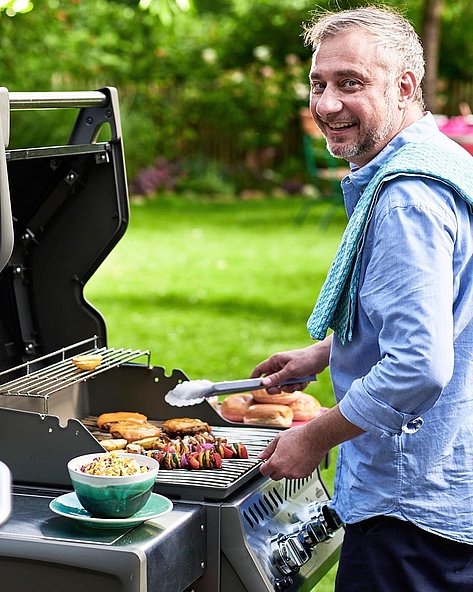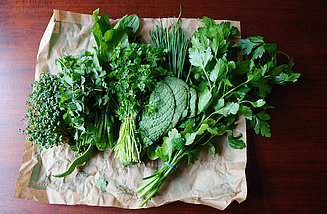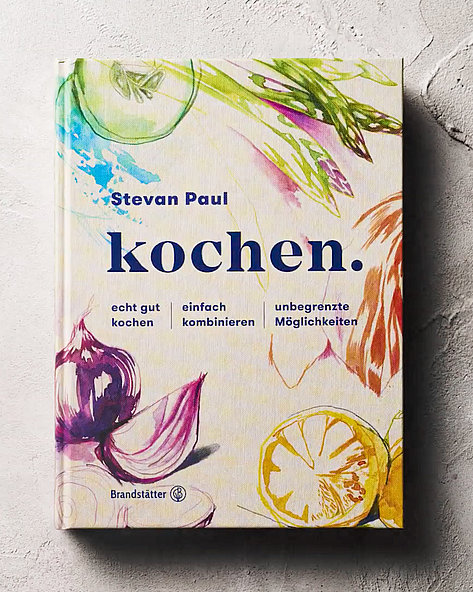Interviewed: Food journalist Stevan Paul about the most important details when cooking
5 min readMr Paul, when did you first become interested in cooking?
I was lucky enough to grow up in a family in which cooking and savouring food were highly valued. My parents were still students when I was born. With their first wages, they subscribed to ‘Menü’, a series of books that has now become legendary. Then all of the children were allowed to have our say and help with cooking; we explored different national cuisines and trends – I am still somewhat traumatised by the short, but very intense green spelt fad in the late 1980’s (laughs). Our grandmothers in Hesse and Northern Germany were also wonderful cooks, and there was a barstool for me in every kitchen so that I could see everything and ‘help’.
Let us move on to attention to detail: What is most important when it comes to cooking? Is there a minor detail that is disproportionately important there?
Eckart Witzigmann once said: ‘Cooking is the sum of minuscule details of infinite importance.’ For another great chef, French minimalist Alain Ducasse, cooking is all about ‘the perfect product and knowing the right cooking time.’ I now believe the truth is somewhere between the two extremes. In fact, it is countless details that make up a dish: from talent, form on the day and tools, to the product quality, cuts and cooking techniques. It is also important not to drive yourself crazy striving for perfection in every little thing. All you need is a truly good product, an idea and you are ready to go: cut a perfectly ripened tomato into slices, season just with salt, steep it briefly and drizzle with finest olive oil – that alone is a delight. Another treat is mushrooms fried in butter, salted ... Grind Parmesan cheese over the top and add a few drops of balsamic vinegar for an unreal experience.
What is your favourite dish, your favourite ingredient, your favourite pan?
‘Green Sauce’ from Frankfurt. With boiled beef. With hard-boiled eggs. With asparagus. Or with really good potatoes. It is simple and (simply) great! My favourite ingredient is the onion. Lots of good things in the kitchen start with onions, and the smell of onions braised in butter is my absolute favourite smell in the kitchen. On the other hand, I do not have a favourite pan. But I do have an old sauté pan that I really love.
Do cooking and building have anything in common?
I think so. The cook creates a menu, building a carefully thought-out architecture of flavours, shaping the evening. First and foremost, that is in particular an expression of personality, talent and creativity – but also intended to enthuse, surprise, inspire, and ideally to touch people.
How is a dish built on a plate – in structure, aesthetics and taste?
Arranging a plate is often an expression of a new trend, a culinary philosophy, and often closely tied to an additional function: how the individual elements are arranged can subtly guide the diner through the dish. Retrospectively, German plates were first modernised in the 1970s. Dishes were laid out with greater care and in clearer arrangements, visually implementing the development towards a new form of cuisine. This marked the transition from the greedy gluttony of the years of the ‘economic miracle’ to superior gourmet dining. In 1980s Nouvelle Cuisine, the ingredients were generally formed into a tower in the middle of the plate – focusing on the overall creation, which was to be experienced as a whole in every bite. In recent years, cuisine has been gradually expanding, with edible landscapes populating more plate real estate in fine dining restaurants. Meadows of herbs and streams of sauce wind their way in dabbed dots between bulging sponges, spheres, balls and cubes. Besides the playful dishes of more recent modern cuisine, a new minimalist flavourful cuisine with few curated ingredients is dawning. Trust in the intrinsic flavours of regional produce is returning, ecological thinking and respect for natural resources are non-negotiable for the new generation. As a result, these presentations offer a contrast to the edible landscapes: a few components are presented in a more concentrated and minimalist form – beside one another or stacked. Deep bowls are used, which also keep sauces and essences concentrated in the centre. Here too, functional considerations play a part: a departure from thickened sauces towards concentrated intrinsic flavour requires tableware that prevents aromatic essences flowing away.
What is the best approach to herbs and spices? What details are important?
That is a complex question! As a rule, I always recommend buying herbs and spices in the smallest packages available, and buying fresh as often as possible. Dried herbs and spices handle heat better and longer, they really blossom when braising and cooking, while fresh herbs should not be added until the end as a finishing touch. It also helps to give them a little clap (laughs), that breaks down the cell structure and releases the essential oils – but do not delay adding them to your food afterwards! And one last request: never roughly chop herbs. Not even parsley. Always cut them finely. Chopped parsley often tastes like cut grass, for example, while freshly cut parsley is a revelation.
Can you give us five don’ts when cooking…?
Blunt knives, lovelessness, hubris, too much salt and too little salt.
… and five must-haves …
Sharp knives, good products, self-confidence, attentiveness and good music.
What have you achieved to date? What do you still want to achieve?
I have been cooking professionally for 30 years, first as a trained chef in award-winning restaurants, then as a food stylist and editor and as an author of cookbooks and food journalist for over ten years now. I have campaigned for and written about good food, and published numerous cookbooks. Over time, one thing has become more and more important to me: talking about the freedom and joy that cooking gives us. Anyone who cooks is self-reliant. In an age when people are always trying to explain to us what we should be eating, what we have to eat and what we definitely should not eat anymore, my book ‘kochen.’ (‘cooking.’) is a plea for more individuality in the kitchen. With recipes broken down into small recipe elements that can be combined freely, I found a structural way of breaking down the barriers to getting started, but also to help readers cook their way to their own taste. Countless variants, suggestions and tips help them along the way. Only those who know their own taste are truly free to choose. Readers who want more in-depth information can learn the basics of the trade in the reference sections. The wonderful working title for this new culinary standard reference book was ‘Cook whatever you want!’. This will be the way forward for my work in future: recipe proposals not prescriptions.
Stevan Paul …
… comes from Lake Constance and has lived in Hamburg, Germany for 25 years. Today, the trained chef works as a freelance journalist for magazines (including Der Feinschmecker, Effilee, Mixology) and daily newspapers, and is the Süddeutsche Zeitung’s restaurant critic. He has written two books of culinary short stories, the chef novel „Der große Glander“ (‘The Great Glander’) and edited the anthology „Die Philosophie des Kochens“ (‘The Philosophy of Cooking’). His literary works are published by mairisch Verlag, Hamburg. Having authored multiple best-selling cookbooks, his most recent work, „kochen.“ ’ (‘cooking.’, Christian Brandstätter Verlag, 2019) is a new standard culinary reference work. In „NutriCulinary“ , Paul also runs one of the most-read online culinary magazines in the German-speaking world.





